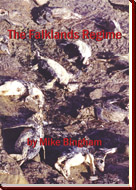 |
 |
|
|
|
|
|
|
|
|
|
|
|
|
|
||||||||||||||||||||||||||||||||||||||||||
|
|
||||||||||||||||||||||||||||||||||||||||||||
| GENERAL
INFORMATION The Falkland Islands lie in the South West Atlantic approximately 450 kilometres north-east of Tierra del Fuego, between latitudes 51 and 53 degrees south, and longitudes 57 and 62 degrees west. The archipelago is made up of two main islands, East and West Falkland, and over seven hundred smaller islands and islets, comprising a land area of just over 12,000 square kilometres. There are three principal mountain ranges with land over 600m: the Wickham Heights on East Falkland, and Mount Adam and the Hornby Mountains on West Falkland. These upland areas, along with most of West Falkland, are largely underlain by Palaeozoic rocks which tend to form rugged landscapes and coastlines, whilst the lowland areas of East Falkland, predominantly Lafonia and surrounding islands, are underlain by younger Mesozoic rocks which give a flatter landscape. These differing coastlines and terrain each provide features suitable for particular fauna and flora, resulting in associations between geology and species composition. Most lowlands tend to have acidic peaty soils, which are generally of low fertility and which tend to support Dwarf Shrub Heath on the drier areas and Grassland on the wetter terrain. Where nutrient levels are higher, finer grasses and sedges are often supported as a short turf. Such Greens can be the result of natural nutrification, such as run-off from surrounding land or mineral deposits, or from animals such as penguins, geese and rabbits. Equally the high nutrient levels could be the result of agricultural practices, such as the intensive grazing of livestock, in which case such greens would more correctly be termed Pasture. The upper reaches of mountains and ridges generally have clay or stony soils, and these conditions combined with exposure favour the growth of cushion plant communities called Feldmark. Tussac Grass (Parodiochloa flabellata) is restricted to coastal areas by its requirements for moist, salt-laden air. Its sensitivity to uncontrolled grazing means that today it exists in only about 20% of its former range, generally where protected from livestock. This sensitivity to grazing is also true for shrubs such as Fachine (Chiliotrichum diffusum) and Native Box (Hebe elliptica). The majority of the remaining tussac grass is found on offshore islands, with many smaller islands being completely covered. These islands often provide suitable habitat for breeding birds rarely found on the mainland, including small burrowing petrels and passerines such as Cobb`s Wrens and Tussock-birds. These species are susceptible to introduced predators such as rats and cats, and tend not to be found on the mainland or on offshore islands which do have rats. The Falklands has a cool, temperate, oceanic climate, dominated by westerly winds. Average monthly temperatures range from around 9 degrees Celsius during the austral summer (January/February) to about 2 degrees Celsius during the austral winter (June/July). Because of prevailing westerly winds, areas on the leeward side of the mountain ranges tend to have higher annual rainfall than those on the westerly windward side. Port Stanley and Port Howard both have around 63cm per annum, which is greater than on westerly islands such as Westpoint, which averages only 43cm per annum. As a result of the differences in rainfall, geology and topography, the ground tends to remain drier in the west, with consequential differences being evident amongst the vegetation and associated fauna. The Falkland Islands lie on the south westerly edge of the Patagonian continental shelf, where an abundance of marine species provide rich feeding for seabirds and marine mammals. The Falklands also lie to the north of the Antarctic Convergence, where cool surface waters to the south meet warmer surface waters from the north. This helps to moderate the climate, and prevents prolonged snow and ice cover. This division of ocean currents is reflected in the marine species found, with krill (Euphausia sp.), an important part of the food chain of the cooler southern waters, being replaced by Lobster Krill (Munida gregaria) in the warmer waters north of the convergence. The climatic differences brought about by the comparatively warmer waters also affect the flora and fauna found on land, and this is evident from the differing characteristics of the Falklands and South Georgia. The author qualified as a Biological Surveyor in 1990, with specialist training in Bird Census and Habitat Classification techniques. Following employment with The National Trust, Gwynedd County Council and the Hawaii Volcanoes National Park Service, all regions where Biological Surveying was standardised, the author moved to the Falklands where no previous survey work had been done. Whilst under the employment of Falklands Conservation, initial studies were carried out using standard UK survey techniques, in order to determine the basic habitat types applicable to the Falklands. Since then the author has conducted Phase 1, Phase 2 and Phase 3 Baseline Surveys throughout the Falkland Islands, with over 800 sq.km. of terrestrial habitat and over 500 km of coastline having so far been surveyed according to NCC/MNCR approved methodology (Hicock 1990: Nature Conservancy Council CSD Report No. 1072 / Marine Nature Conservation Review Occasional Report MNCR/OR/05). Survey data, combined with detailed studies of individual species, have been used to evaluate habitat types, and their associated flora and fauna. The general conclusions of this work are presented below. |
||||||||||||||||||||||||||||||||||||||||||||



